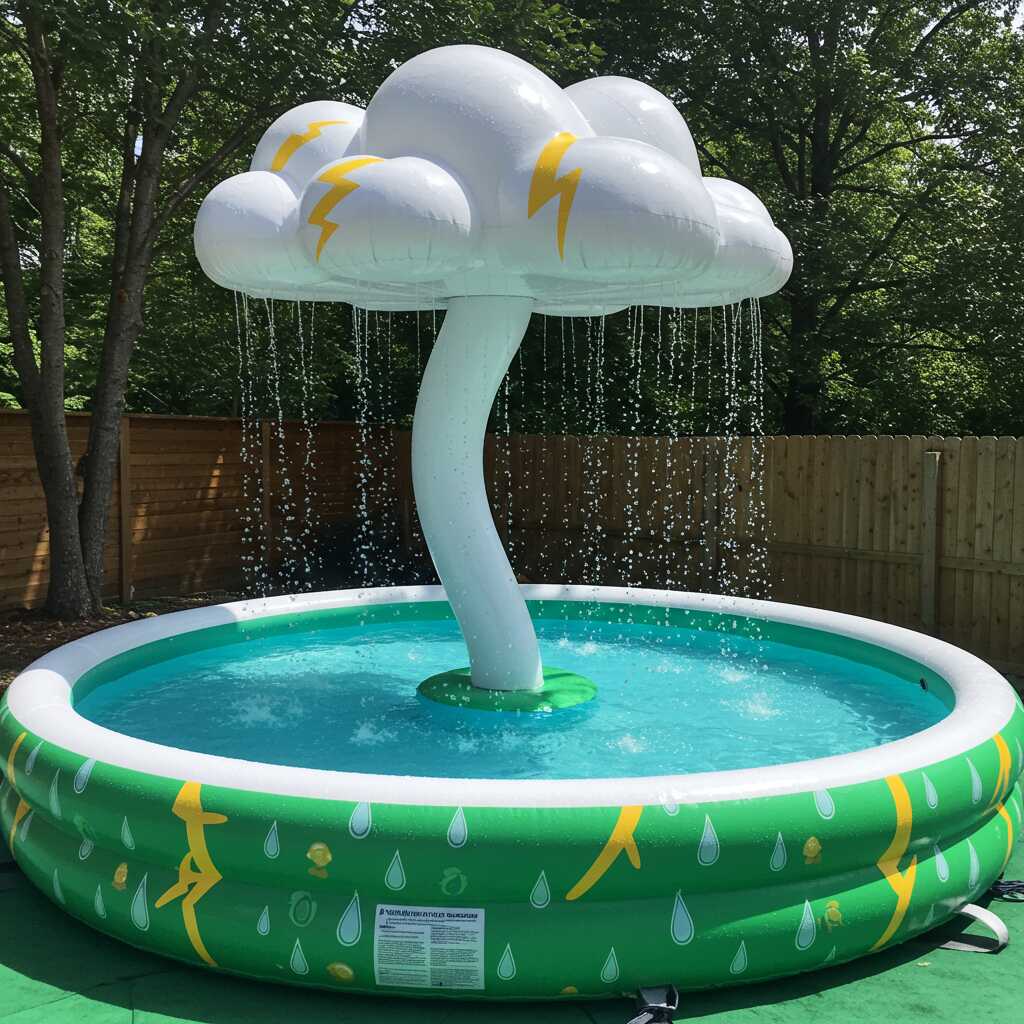In recent years, the world of garden decor has witnessed a fascinating evolution that marries functionality with artistic expression, leading to innovative and unexpected designs. Among these emerging trends, motorcycle-inspired planters have captured the imagination of gardening enthusiasts and design aficionados alike. This unique fusion of mechanical aesthetics and natural elements represents more than just a passing fad; it embodies a cultural shift towards more personalized and meaningful outdoor spaces. The “Motorcycle Shaped Planter” concept has emerged as a particularly intriguing manifestation of this trend, offering gardeners an opportunity to express their individuality while creating visually striking focal points in their landscapes.
The appeal of motorcycle-shaped planters extends far beyond their novelty factor. These distinctive garden features tap into several contemporary design movements, including industrial chic, vintage revival, and sustainable repurposing. As urban spaces become increasingly compact and people seek ways to maximize their outdoor areas, these creative planters provide both practical solutions and aesthetic enhancements. They represent a departure from traditional terra cotta pots and hanging baskets, introducing dynamic forms that can transform even the smallest balcony or patio into a conversation-worthy space.
What makes motorcycle-shaped planters particularly compelling is their ability to bridge multiple design philosophies. They honor the craftsmanship and engineering excellence associated with motorcycles while embracing the organic beauty of plants and flowers. This juxtaposition creates a visual dialogue between man-made precision and nature’s spontaneity, resulting in a harmonious blend that appeals to diverse aesthetic sensibilities. Whether crafted from recycled materials or designed as entirely new pieces, these planters demonstrate how functional objects can transcend their primary purpose to become works of art in their own right.
The rising popularity of motorcycle-inspired planters also reflects broader societal trends toward personalization and self-expression in home and garden design. In an era where mass-produced items dominate retail spaces, these unique planters offer gardeners the chance to showcase their individuality through unconventional yet sophisticated design choices. From sleek, modern interpretations to rustic, vintage-inspired pieces, motorcycle-shaped planters cater to various tastes while maintaining their core identity as innovative garden elements. This versatility ensures their relevance across different design contexts, from urban lofts to suburban backyards, making them a significant player in contemporary garden decor trends.
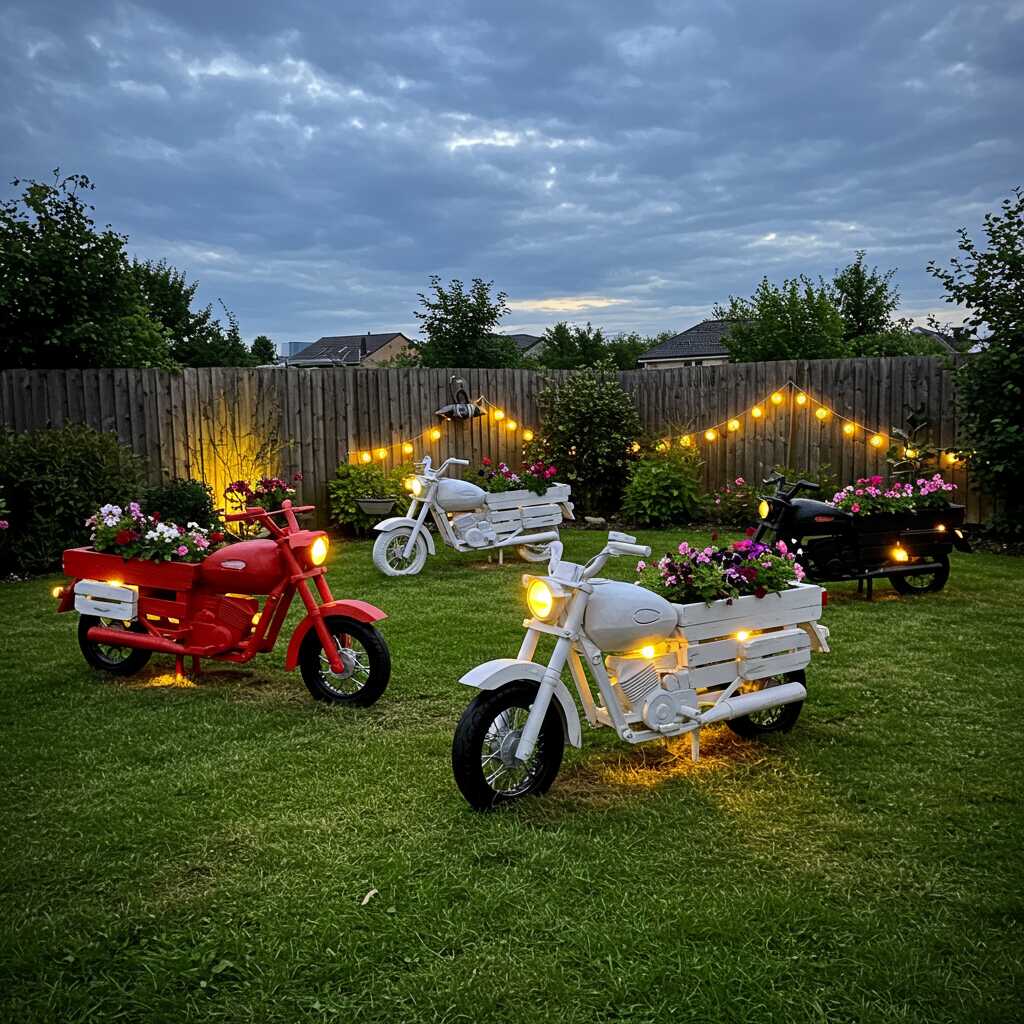
The Evolution of Garden Decor: From Functional to Artistic Expressions
The journey of garden decor has undergone remarkable transformation over the decades, evolving from purely utilitarian objects to sophisticated expressions of personal style and artistic vision. Traditional garden ornaments such as stone statues, basic flower pots, and wrought-iron trellises dominated outdoor spaces for generations, serving primarily functional purposes while adhering to conventional aesthetic standards. These classic elements typically emphasized symmetry, formal arrangements, and time-tested materials like terracotta, concrete, and wood, reflecting a more conservative approach to outdoor decoration.
However, as design sensibilities evolved throughout the late 20th century, garden decor began to embrace more experimental forms and materials. The minimalist movement of the 1980s introduced sleek metal sculptures and geometric planters, while the 1990s saw a resurgence of interest in natural materials and organic shapes. This period marked the beginning of garden decor’s transition from mere functionality to artistic statement, with designers increasingly viewing outdoor spaces as extensions of interior living areas. Water features, contemporary sculpture installations, and custom-designed seating arrangements became common elements in modern gardens, signaling a shift toward more personalized and expressive outdoor environments.
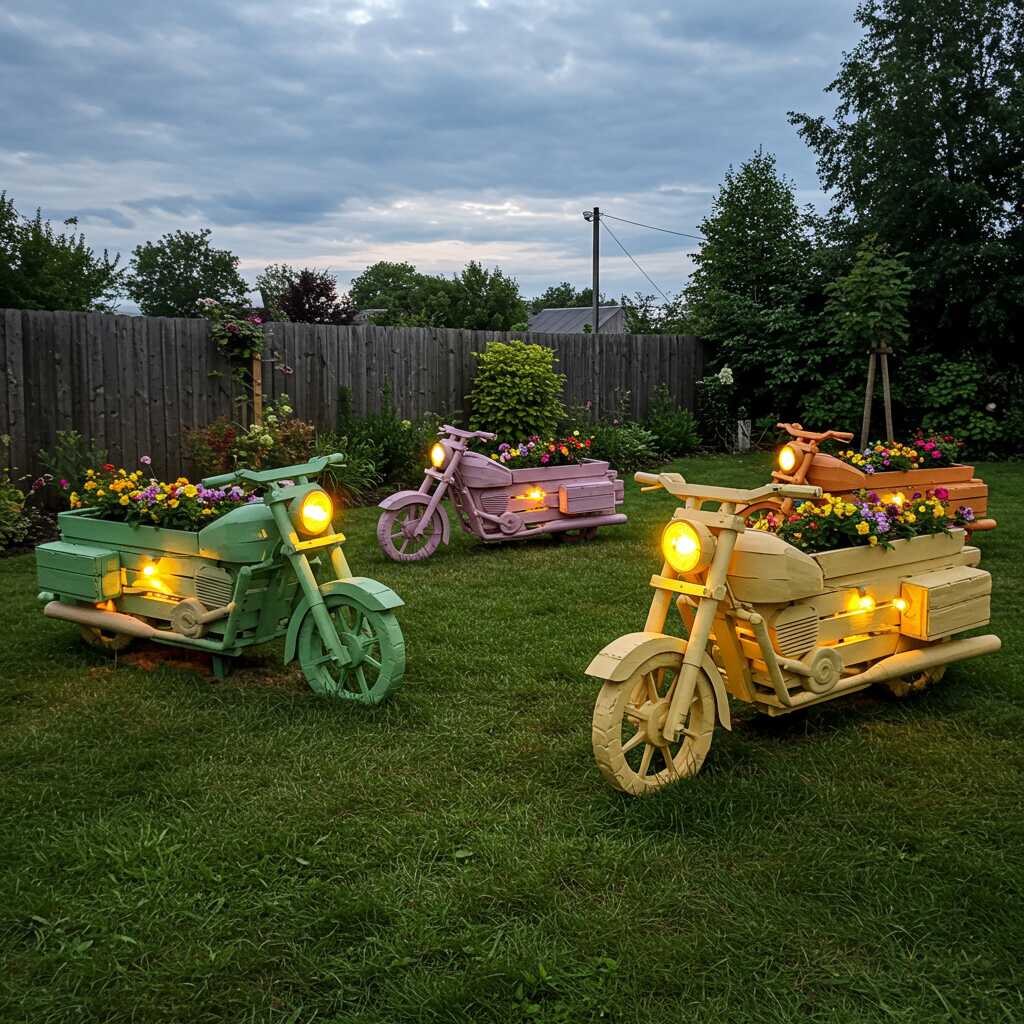
The twenty-first century ushered in an era of unprecedented creativity in garden design, characterized by bold experimentation with form, material, and concept. This evolution reached its peak with the emergence of thematic and conceptual garden elements, where objects traditionally associated with other contexts found new life in outdoor settings. Industrial artifacts, automotive parts, and mechanical components began appearing in garden designs, challenging preconceived notions about what constituted appropriate outdoor decor. This movement toward unconventional garden elements paved the way for innovations like motorcycle-shaped planters, which exemplify the current trend of blending disparate design languages to create unique visual narratives.
Contemporary garden decor now exists at the intersection of multiple design disciplines, incorporating elements from architecture, sculpture, fashion, and industrial design. The rise of sustainable design practices has further fueled this evolution, encouraging the repurposing of existing materials and objects into functional garden elements. This approach has led to the creation of truly unique pieces that tell stories through their form and composition, moving far beyond the limitations of traditional garden ornaments. The success of motorcycle-inspired planters demonstrates how this evolution has created space for innovative designs that celebrate both form and function, while honoring the rich history of garden decor’s development.
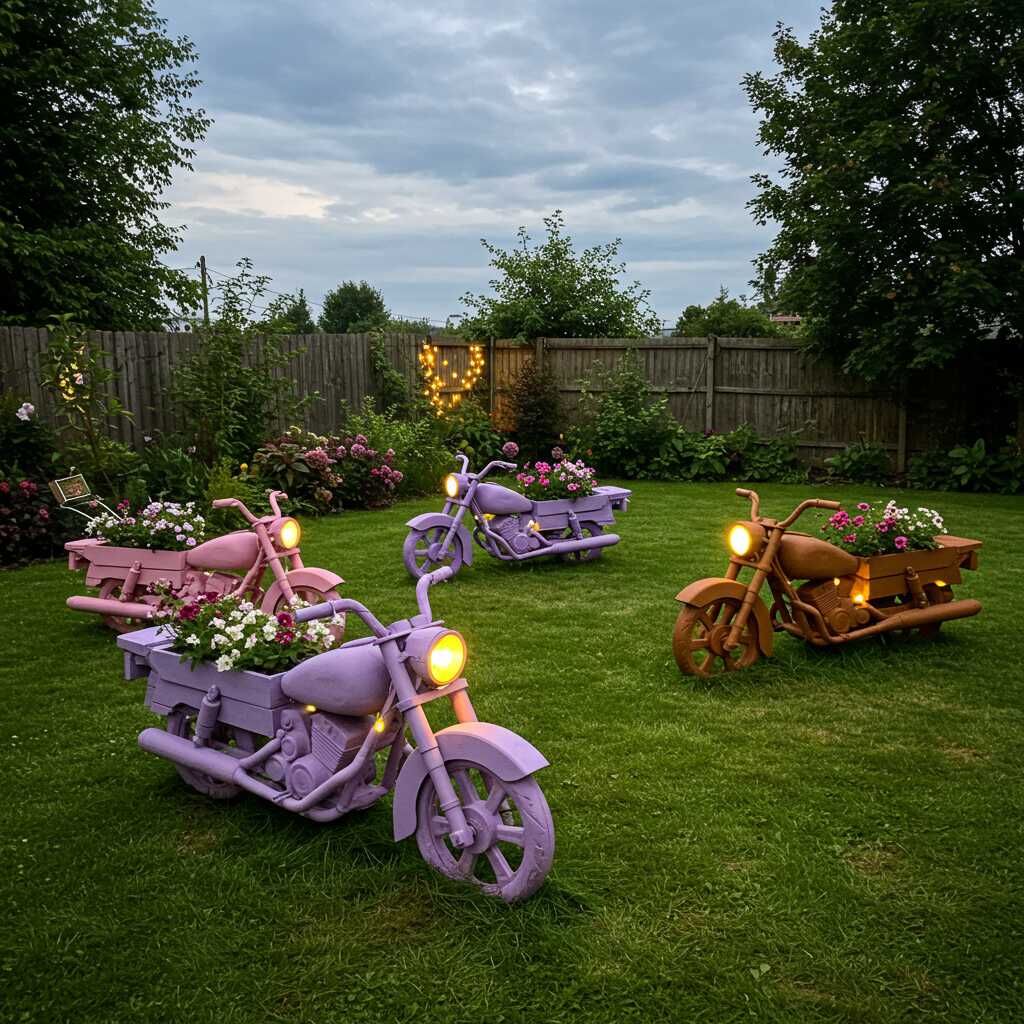
Design Elements and Cultural Significance: The Motorcycle Shaped Planter Phenomenon
The motorcycle-shaped planter represents a masterful synthesis of design elements drawn from both the world of horticulture and motorcycle culture. At its core, this innovative garden element captures the essence of motorcycle aesthetics through carefully considered proportions and detailing. The elongated body, reminiscent of a motorcycle’s frame, provides ample planting space while maintaining the sleek profile characteristic of two-wheeled vehicles. Designers often incorporate subtle references to motorcycle components, such as handlebar-like supports for trailing vines, spoke-pattern drainage holes, and wheel-inspired base structures, creating a cohesive visual narrative that resonates with enthusiasts of both gardening and motorcycling.
The cultural significance of motorcycle-shaped planters extends deep into the realm of symbolism, bridging two seemingly disparate worlds through shared values and aesthetics. Motorcycles themselves embody freedom, adventure, and rebellion against convention – attributes that find unexpected parallels in the act of gardening. Just as motorcycle riders carve their own paths along open roads, gardeners cultivate their personal visions of beauty and growth in their outdoor spaces. The marriage of these concepts in a single object creates a powerful metaphor for personal expression and independence, appealing to those who appreciate the spirit of nonconformity in both transportation and lifestyle choices.
Material selection plays a crucial role in enhancing both the functionality and symbolic meaning of motorcycle-shaped planters. Modern versions often utilize weather-resistant metals that echo the industrial heritage of motorcycle manufacturing, while others incorporate recycled automotive parts to emphasize sustainability and resourcefulness. Some designs feature distressed finishes that mimic the patina of well-loved motorcycles, adding layers of texture and character that speak to the passage of time and accumulated experiences. These material choices not only ensure durability but also contribute to the authentic representation of motorcycle culture within the context of garden decor.
The spatial dynamics of motorcycle-shaped planters make them particularly versatile in various garden settings. Their linear form allows for strategic placement along pathways, creating visual rhythm similar to a row of parked motorcycles. When positioned individually, they serve as striking focal points that draw the eye and invite closer inspection. The vertical orientation of many designs enables efficient use of space while allowing plants to cascade downward, mimicking the flow of air around a moving motorcycle. This thoughtful integration of form and function demonstrates how these planters transcend their basic purpose to become meaningful design elements that enhance both small urban balconies and expansive garden landscapes.
Perhaps most significantly, motorcycle-shaped planters embody the contemporary cultural phenomenon of cross-pollination between traditionally masculine and feminine domains. By combining elements associated with motorcycling – often perceived as rugged and mechanical – with the nurturing aspects of gardening, these designs challenge conventional gender associations and create space for new forms of self-expression. This duality reflects broader societal shifts toward more inclusive and fluid interpretations of hobbies and interests, making motorcycle-shaped planters not just decorative objects but symbols of evolving cultural attitudes.
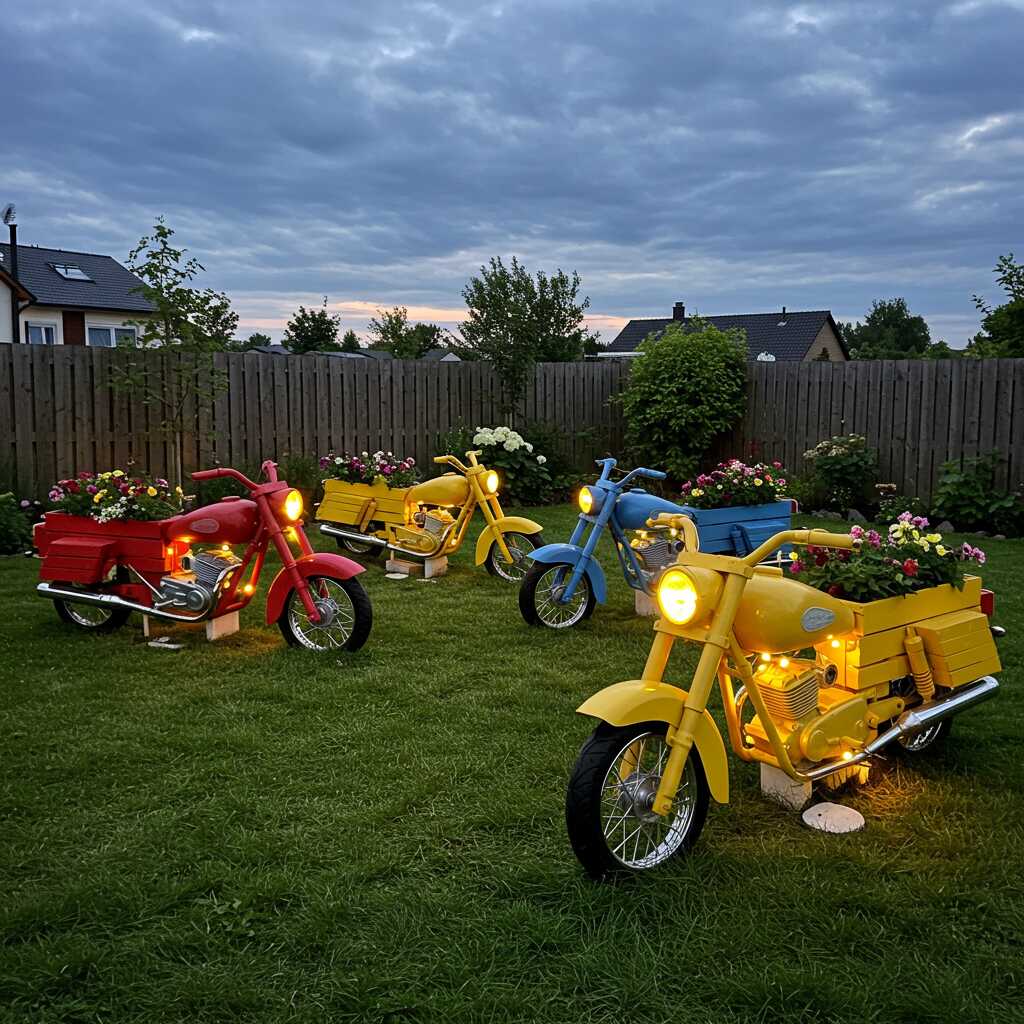
Practical Applications and Creative Integration: Maximizing Motorcycle Shaped Planters
The versatility of motorcycle-shaped planters extends far beyond their initial visual impact, offering innovative solutions for diverse garden challenges through thoughtful design and strategic placement. In urban settings where space constraints often limit traditional gardening options, these planters excel as vertical gardening solutions. Their elongated forms naturally lend themselves to tiered planting arrangements, where trailing vines can cascade down the sides while upright specimens occupy the central planting area. This three-dimensional approach to plant arrangement maximizes growing space while creating dynamic visual interest, transforming narrow corridors or balcony edges into lush green sanctuaries.
The structural characteristics of motorcycle-shaped planters make them particularly effective as space dividers and privacy screens in open garden areas. When arranged in groups or lines, their consistent profile creates natural partitions that define different zones within a landscape without obstructing airflow or light penetration. This application proves especially valuable in community gardens or shared outdoor spaces, where discreet separation of growing areas maintains communal harmony while preserving individual plots’ distinct identities. Additionally, their height and form naturally deter casual trespassing while maintaining an inviting aesthetic.
Seasonal versatility represents another significant advantage of motorcycle-shaped planters. During warmer months, they serve as vibrant displays for flowering annuals and tropical foliage, while in cooler seasons, they can host hardy perennials and evergreen arrangements that maintain year-round interest. Some designs incorporate removable panels or modular components, allowing gardeners to adapt their configuration according to seasonal needs or changing plant requirements. This flexibility extends to maintenance practices as well, with many models featuring integrated drainage systems and easy-access planting areas that simplify care routines.
Lighting integration has emerged as a particularly innovative application of motorcycle-shaped planters in evening garden design. Many contemporary versions incorporate discreet LED strips along their frames or within hollow sections, creating dramatic silhouettes after dark. This feature transforms them from daytime garden accents into nighttime focal points, casting soft illumination that highlights surrounding plants while drawing attention to their distinctive forms. The interplay of light and shadow enhances their motorcycle-inspired details, creating a completely different visual experience during evening hours.
Water management represents another practical consideration where motorcycle-shaped planters excel. Their typically elevated design promotes proper drainage while preventing root rot, while some models incorporate reservoir systems that optimize water usage. The sloped surfaces inherent in their design help direct rainfall efficiently, reducing water waste and ensuring even moisture distribution. For rooftop gardens or areas prone to pooling, these planters provide excellent solutions for managing water flow while maintaining their decorative function.
Community engagement and educational opportunities emerge as unexpected benefits of incorporating motorcycle-shaped planters in public spaces. Their unique form often sparks curiosity and conversation among visitors, making them ideal tools for promoting gardening awareness and environmental education. Schools and community centers have successfully utilized these planters to teach children about plant growth cycles, sustainable practices, and the importance of green spaces in urban environments. The recognizable motorcycle form serves as an accessible entry point for discussions about ecology, design, and the intersection of human creativity with natural processes.
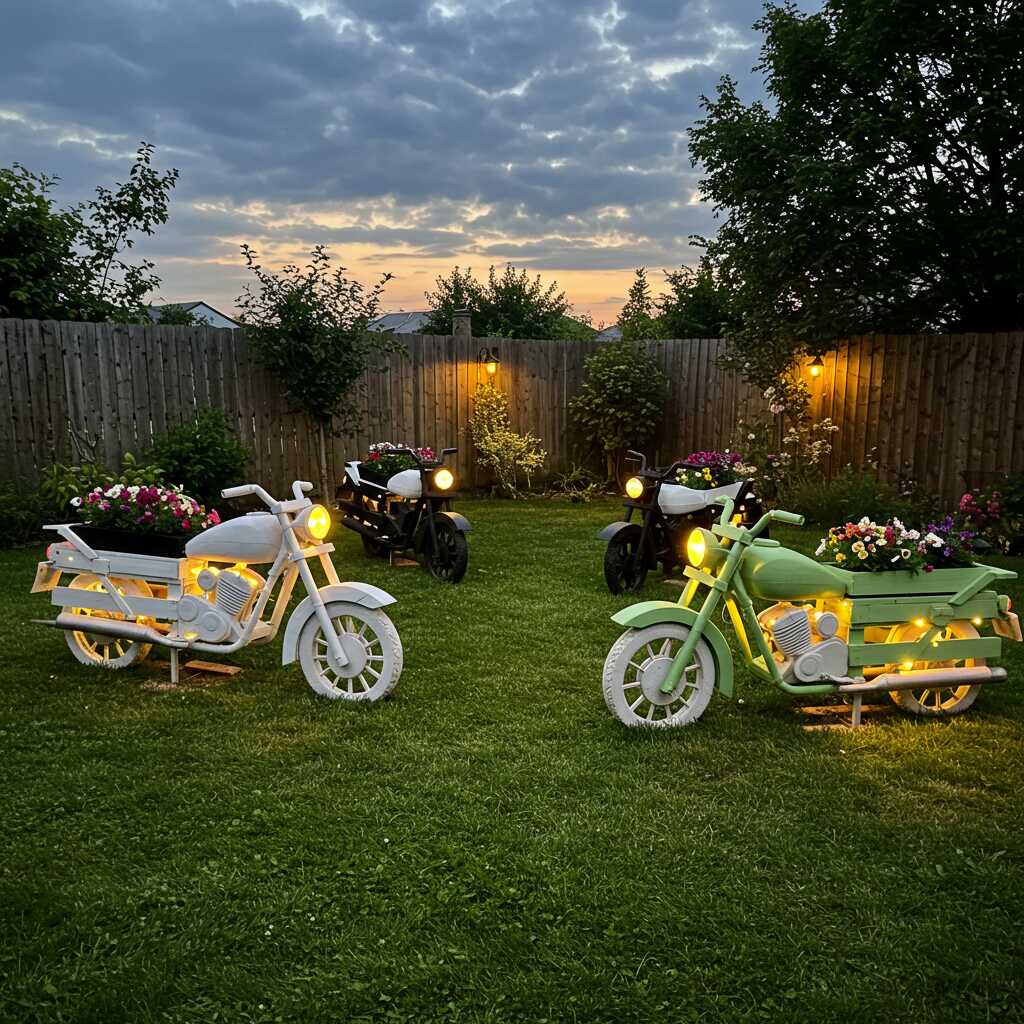
Cultivating Innovation: The Enduring Impact of Motorcycle Shaped Planters
As we reflect on the transformative influence of motorcycle-shaped planters in contemporary garden design, their significance extends far beyond their immediate visual appeal. These innovative creations represent a paradigm shift in how we conceptualize outdoor spaces, challenging conventional boundaries between functional objects and artistic expression. The enduring impact of this trend lies in its ability to inspire new approaches to garden design while fostering deeper connections between diverse cultural elements. By successfully merging the mechanical precision of motorcycle engineering with the organic vitality of plant life, these planters demonstrate how seemingly disparate elements can harmonize to create something greater than the sum of its parts.
The legacy of motorcycle-shaped planters will likely manifest in future garden innovations through their demonstration of successful cross-disciplinary design thinking. As more gardeners and designers embrace the concept of integrating unexpected elements into outdoor spaces, we may witness the emergence of similarly inspired creations that draw from other cultural artifacts and mechanical forms. This trend suggests a future where garden decor evolves beyond traditional categories, incorporating elements from various aspects of human experience to create richer, more meaningful outdoor environments. The motorcycle-shaped planter stands as a pioneering example of how innovation in garden design can emerge from unexpected sources, paving the way for continued exploration of novel forms and concepts.
Ultimately, the lasting influence of motorcycle-shaped planters rests in their ability to democratize design innovation while celebrating individual expression. These unique garden elements demonstrate that creative solutions need not be confined to professional designers or exclusive show gardens but can thrive in everyday spaces maintained by passionate individuals. Their presence in gardens worldwide serves as a testament to the power of imagination in transforming ordinary outdoor areas into extraordinary personal sanctuaries. As garden design continues to evolve, the principles embodied by motorcycle-shaped planters – creativity, adaptability, and cultural resonance – will undoubtedly continue to shape the future of how we interact with and interpret our outdoor environments.

